Houseplants add beauty, greenery, and an organic element to your home. If you’re looking for houseplants that climb, check here! You’ll get the added benefit of enjoying a decorative plant that fills your home with color, life, and beauty.
There are many different species of climbing houseplants, so how do you know which one is best for you? Check out this list of unique vining and climbing houseplants so you can add a luscious aesthetic to your space.
1. Pothos (Scindapsus aureus)
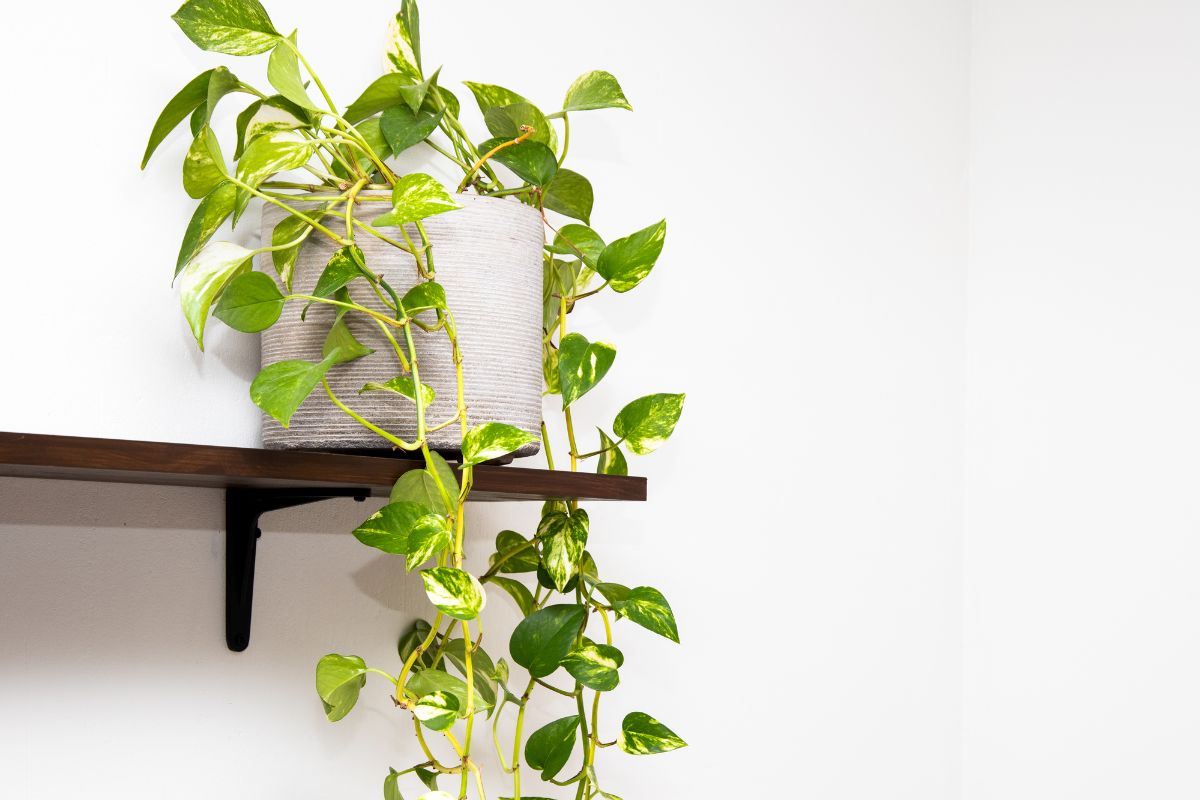
The pothos is one of the most prolific climbing houseplants. This luscious green plant has heart-shaped leaves that are commonly variegated in shades of yellow or white. Pothos plants can grow leaves up to four inches across and they can be planted in a hanging basket or supported upright to climb onto a trellis or totem.
- Sun needs: Pothos do well in almost any amount of sunlight, including low light. Place them in a sunny window, and they’ll grow faster and thrive.
- Water: You can water pothos once every one to two weeks, allowing the soil to completely dry out in between waterings.
- Why this plant is a good fit: Thanks to a fast growth rate and easy care, pothos is one of the easiest climbing houseplants to cultivate and care for in any environment.
2. Philodendron (Araceae)
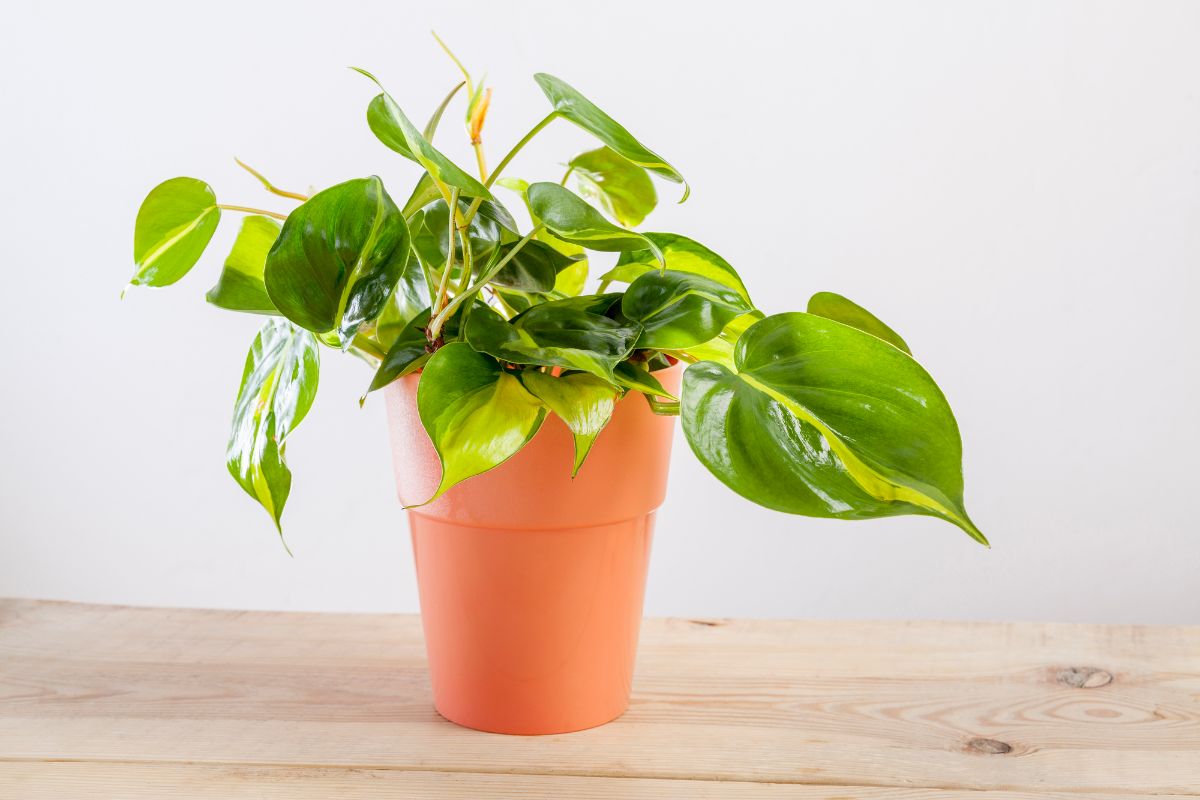
Philodendron is another beautiful climbing houseplant that easily adapts to virtually any environment. These vining, climbing plants feature dark green leaves and have an almost heart-shaped appearance. Make sure you give your philodendron a post or other structure to climb on so the plant has support.
- Sun needs: Place your philodendron in an area that gets bright, indirect sunlight away from direct contact with the sun’s rays. If the leaves turn yellow, your philodendron may be getting too much light, so move it to a slightly shadier location to see how it does.
- Water: Let about the top inch of your soil dry out between watering. You can check the water by sticking your finger into the soil to feel how moist it is. If the leaves look droopy, the plant may need more water.
- Why this plant is a good fit: These climbing houseplants add a fresh, green element to a home or office and they’re fairly easy to care for.
3. Swedish ivy (Plectranthus australis)
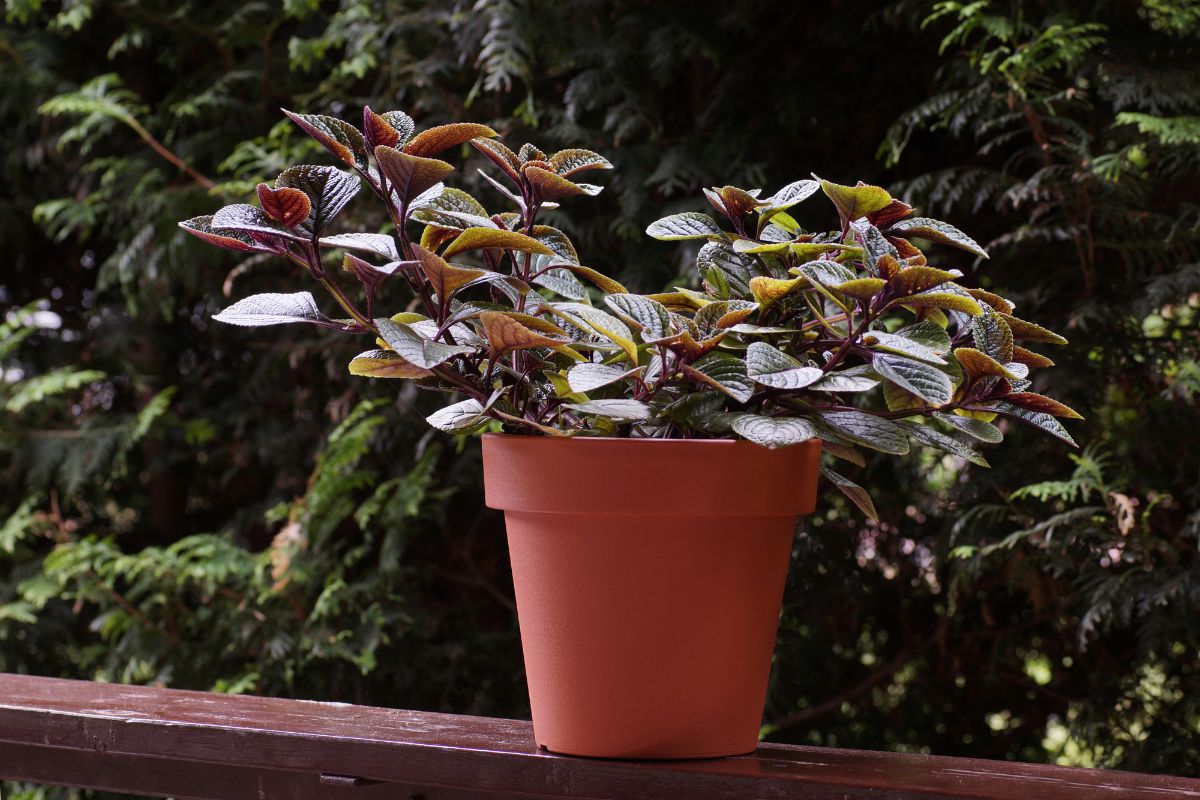
Often displayed in hanging baskets, Swedish ivy is a houseplant native to northern Australia and the Pacific Islands. Its beautiful trailing makes it a prime choice for display in a home, but it may also be planted in containers to use as groundcover outside. The leaves of the Swedish ivy plant are glossy and have beautiful, scalloped edges. It may also bloom mauve or white flowers in the spring and summer.
- Sun needs: Place your Swedish ivy plant in bright, indirect sunlight all year round.
- Water: This climbing houseplant only needs to be water about once per week. Let the soil completely dry in between watering, and never overwater it. Make sure you use a pot that has good drainage to prevent root rot.
- Why this plant is a good fit: This plant is a great fit for this list thanks to its luscious shiny leaves and easy maintenance. Even the most novice gardeners can care for a Swedish ivy plant with few issues.
4. Hoya (Carnosa)
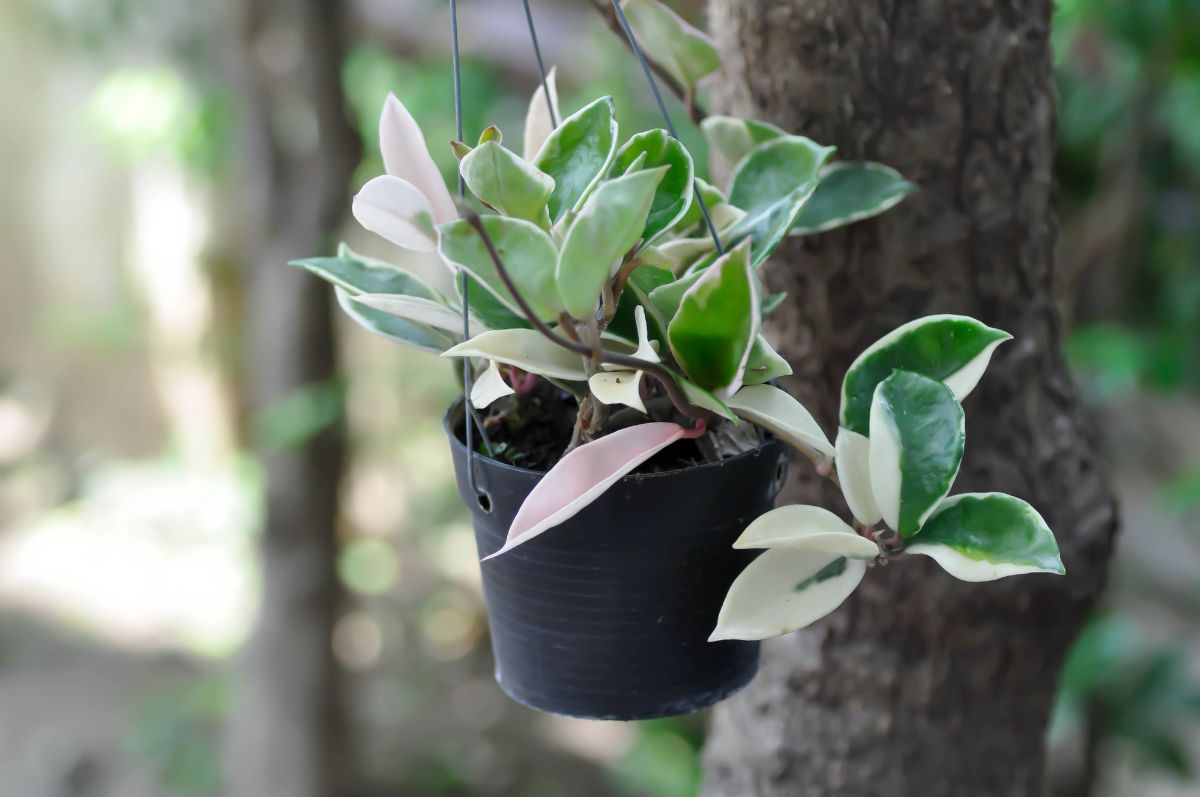
Hoyas are slow-growing, climbing houseplants that feature thick, waxy leaves. These unique plants also produce interesting clusters of small star-shaped flowers that range from white or light to dark pink in color. When the hoya flowers bloom, they sometimes give off a vanilla, chocolate, or cinnamon fragrance.
- Sun needs: Place your hoya in bright, indirect sunlight for the best results. Too much direct sun exposure can cause the leaves to burn or turn yellow.
- Water: Since the hoya is a tropical plant, it thrives in humid conditions. Make sure the soil of your hoya is moist and water it as soon as the dirt gets slightly dry.
- Why this plant is a good fit: This gorgeous climbing houseplant is a unique option that has fascinating clusters of flowers. It’s also safe and non-toxic to humans and pets, making it a great choice for this list.
5. Spider Plant (Chlorophytum comosum)
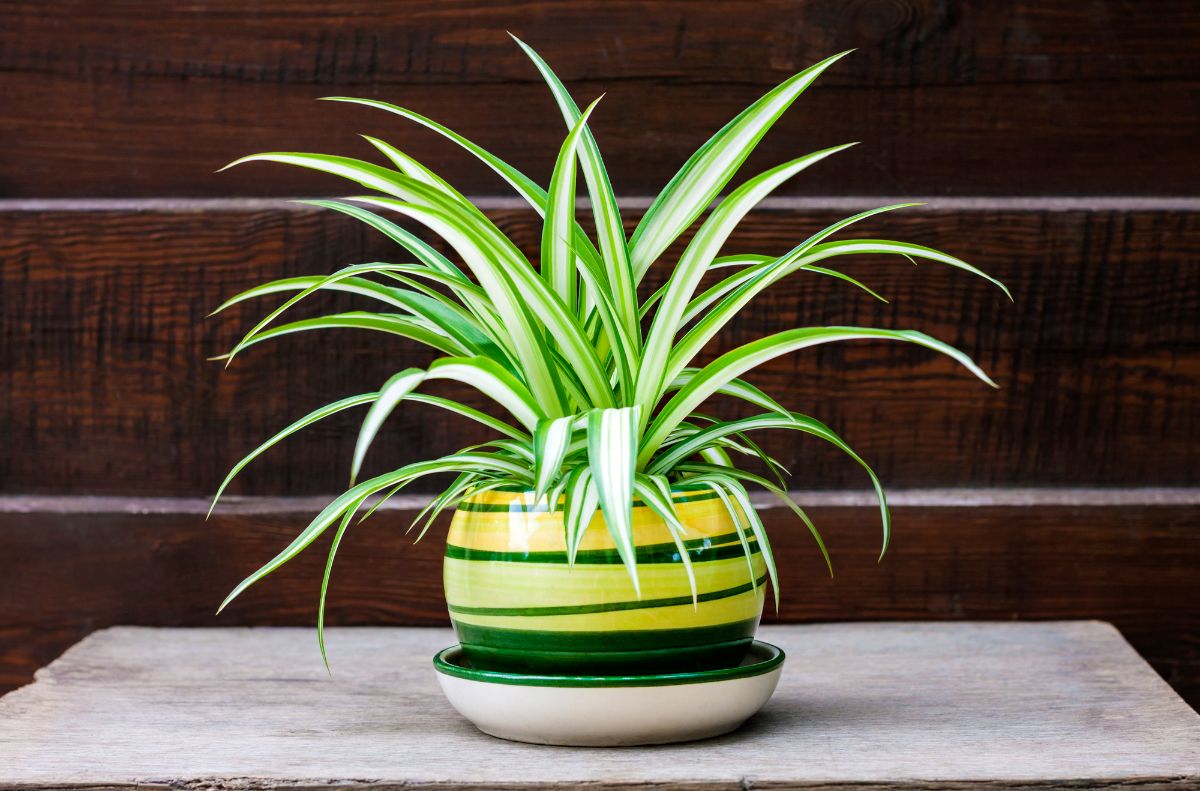
Spider plants have thin, curved foliage that is either variegated with white or solid green in color. These climbing houseplants are easy to grow and look beautiful nestled in a hanging basket or placed below a trellis or pole to help them climb upward. In the warmer months, spider plants may produce tiny white flowers and babu spider plants, called “pups.”
- Sun needs: Keep your spider plant in bright to moderate indirect sunlight. Direct light may burn their leaves or cause the tips to turn brown.
- Water: Water your spider plant occasionally during the first year, then water them moderately thereafter. Make sure you keep the soil consistently moist during the spring and summer to encourage growth.
- Why this plant is a good fit: Not only are spider plants beautiful and easy to grow, but NASA once claimed they’re one of the best plants to help naturally filter and purify the air in your home.
6. Inch Plant (Tradescantia zebrina)
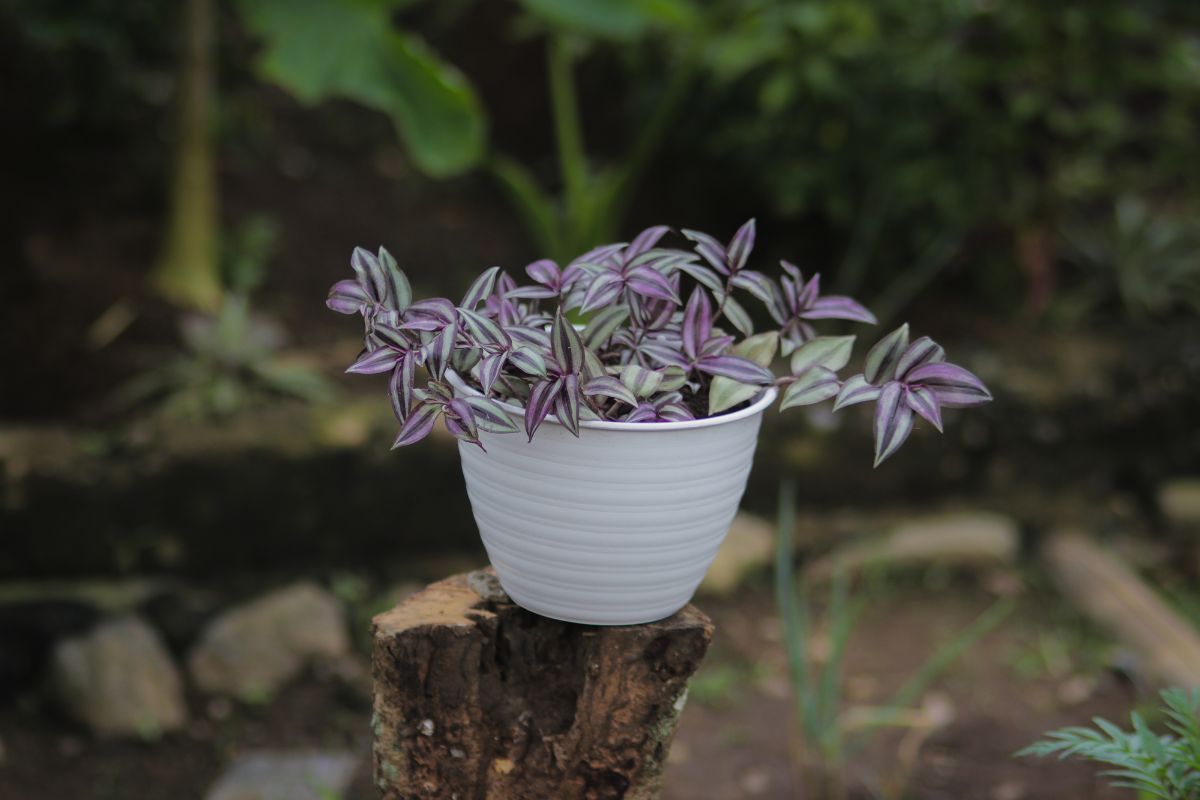
This gorgeous climbing houseplant has deep purple leaves that can range from solid purple to variegated with green. They’re a beautiful option for hanging baskets but also look impressive when used as a tablescape or a climbing vine. You can enjoy the inch plant in your home or office, and they’re fairly tolerant to low light.
- Sun needs: Keep your inch plant in medium to bright light. Although it may tolerate low light for a while, the inch plant thrives when it has access to brighter spaces in your home, like a sunny window.
- Water: Water your inch plant whenever the soil starts to dry out. Overall, you should keep the soil moderately moist at all times.
- Why this plant is a good fit: Not only is the inch plant easy to care for, but its dramatic purple leaves make it a truly show-stopping climbing houseplant.
7. English Ivy (Hedera helix)
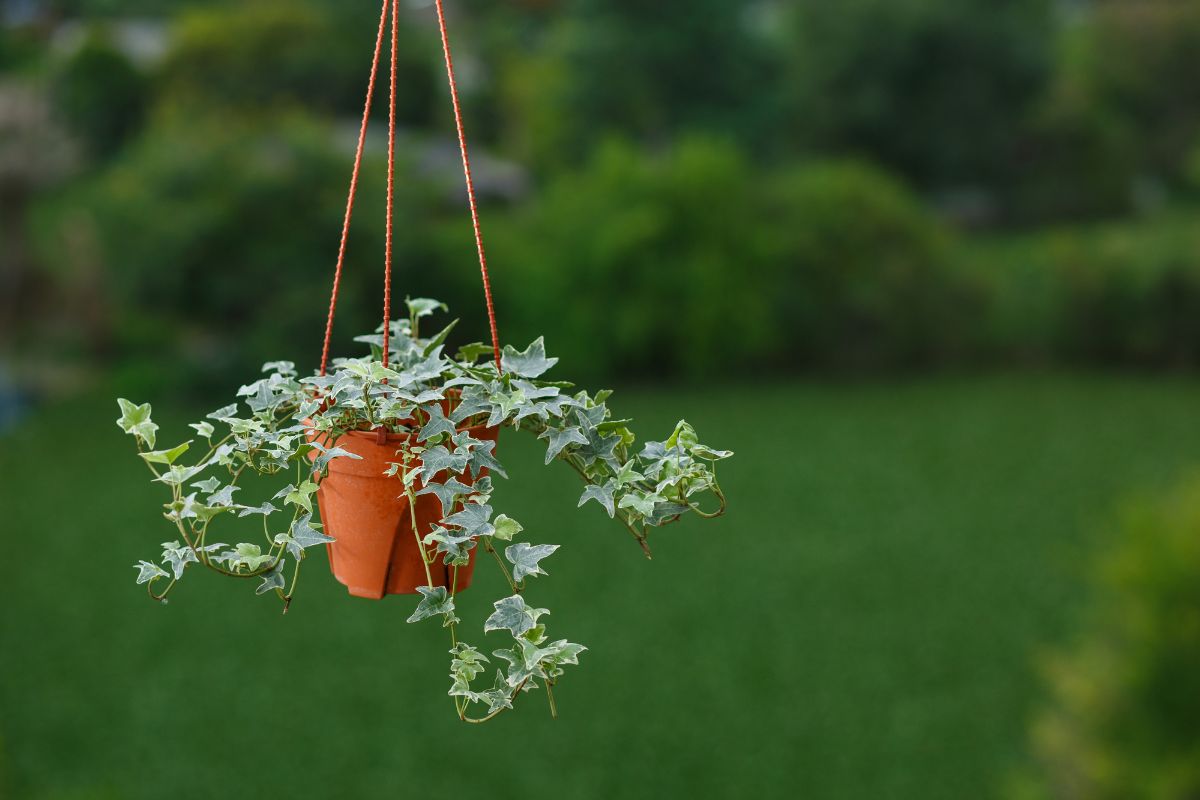
English ivy is probably one of the most widely recognized climbing houseplants. It can be grown indoors, but it’s also considered an invasive species outdoors in certain regions. When growing English ivy indoors, place it in a hanging basket or a planter with a post for support. The long, thin viny stems and variegated green and white leaves make it one of the world’s most iconic plants.
- Sun needs: English ivy can grow in both high and low light. When growing it indoors, keep it near a sunny window if you want it to grow faster.
- Water: Make sure you plant your English ivy in a pot with good drainage. Keep the soil moist and mist the leaves during the winter or whenever the air is dry.
- Why this plant is a good fit: This classic houseplant is extremely easy to grow and care for. When displayed in your home, it adds lush greenery to any room.
8. Burro’s Tail (Sedum morganianum)
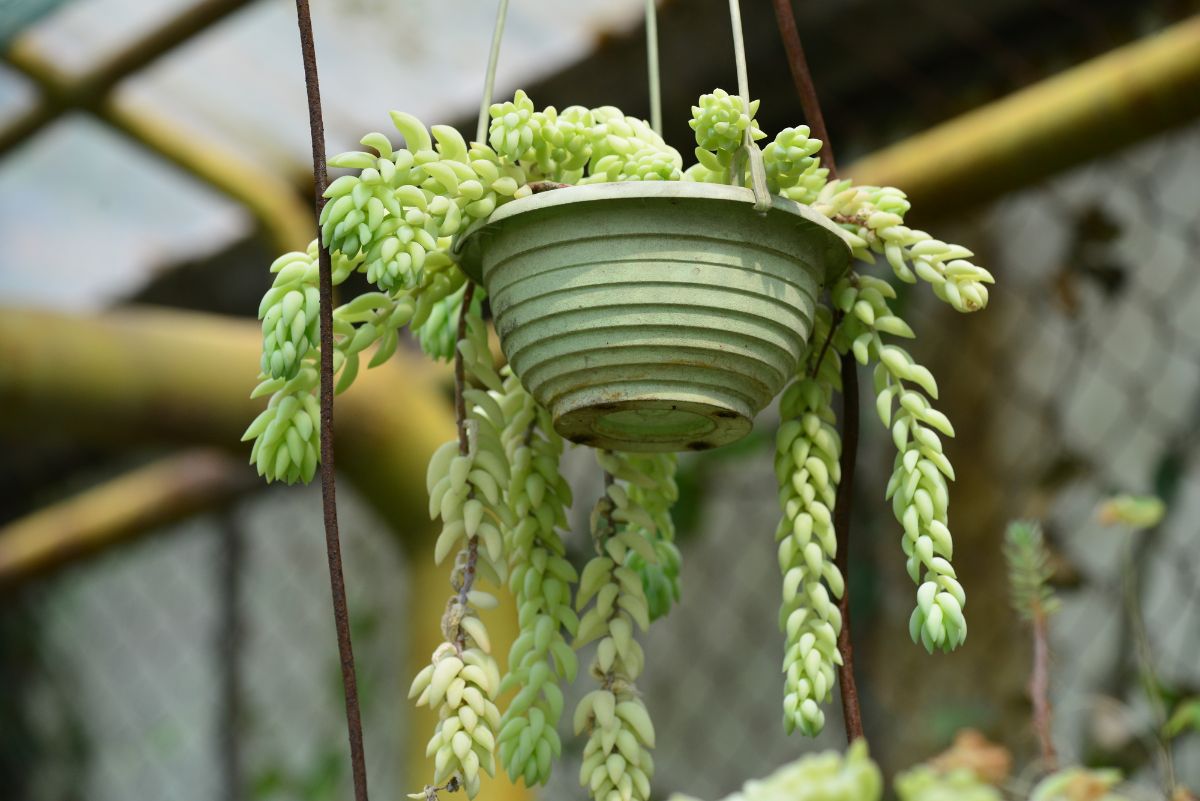
Burro’s tail is a vining succulent that has a bright green color and a unique texture. This unusual houseplant is tolerant to heat and drought and thrives in warm to temperate climates. It features thick stems that grow blue-green leaves that appear to be woven onto the vines. While it doesn’t do as well climbing, it looks luscious as a vining plant nestled in a hanging basket.
- Sun needs: The burro’s tail succulent loves bright, direct sunlight, so keep it in a sunny part of your home for the best results.
- Water: Keep the soil evenly moist and add cactus fertilizer during the spring.
- Why this plant is a good fit: Not only is this houseplant beautiful and fascinating, but it’s fairly easy to grow. It looks lovely in a bedroom, bathroom, or living space and is a great choice for new gardeners.
9. Bleeding Hearts (Dicentra)
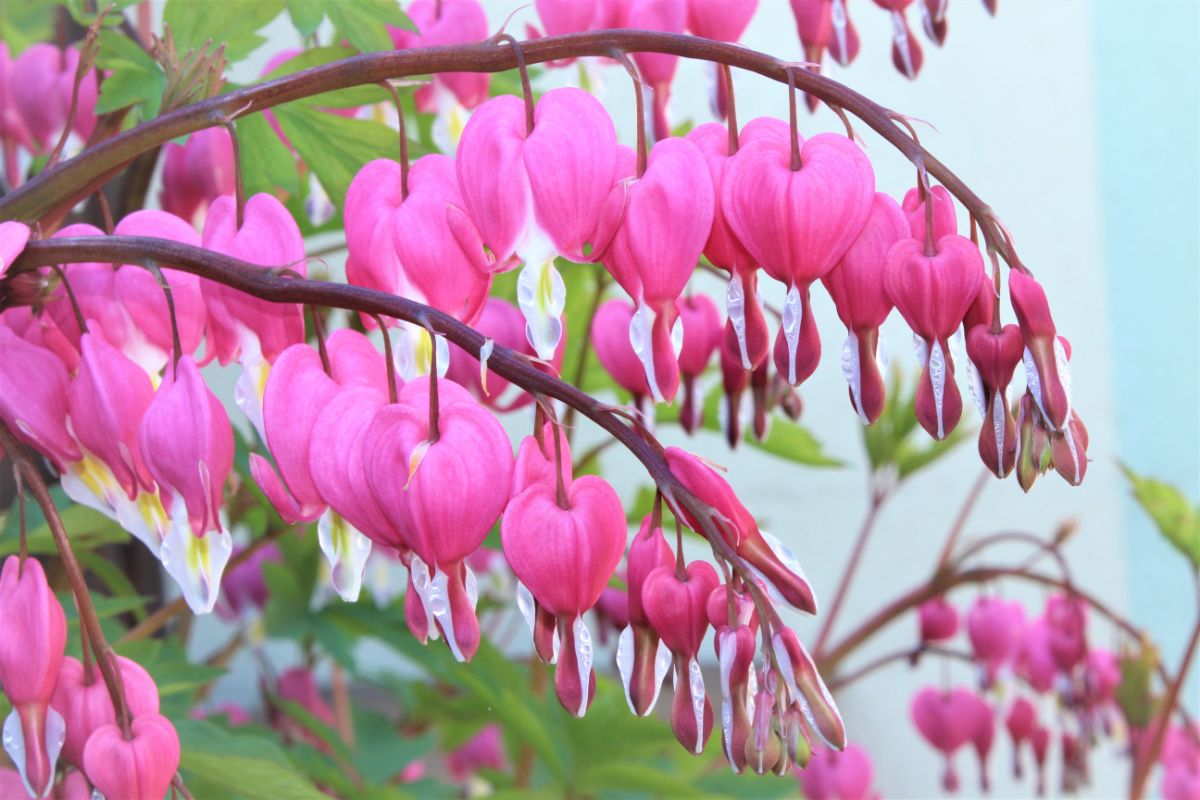
The bleeding-heart plant gets its name from the beautiful blooms of red and white flowers that delicately dangle from its thin branches. This climbing houseplant has thick, lush green vines that add a visually interesting aesthetic to your home. The heart-shaped flowers are what really make this houseplant a truly unique addition to any space.
- Sun needs: Bleeding hearts can easily grow indoors and do quite well in partial sunlight to full shade.
- Water: Keep your bleeding hearts well-watered, especially during the summer. This gorgeous plant requires approximately one inch of water per week to thrive.
- Why this plant is a good fit: When supported by a trellis, bleeding hearts will put on an incredible show whenever they bloom. They add pops of color to every room and look stunning in any type of space.
10. Bougainvillea (Nyctaginaceae family)
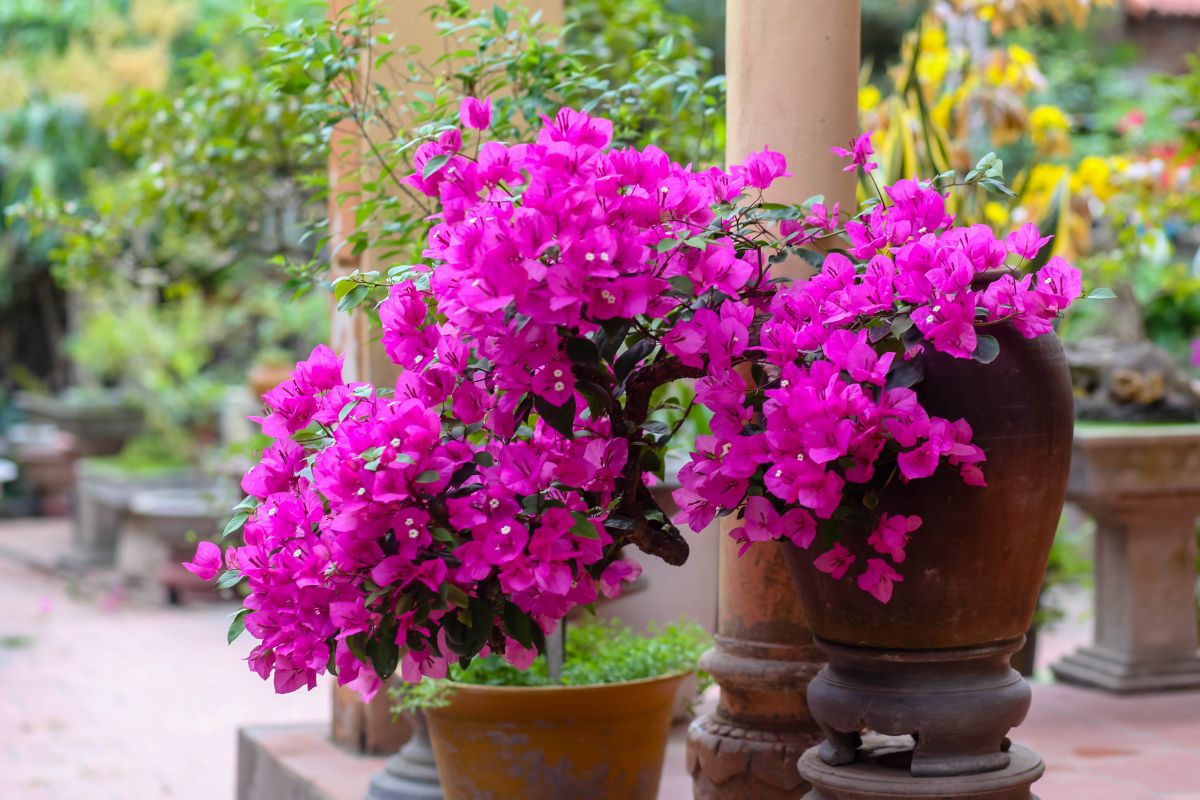
Bougainvillea is a fast-growing climbing houseplant that puts on a fabulous, colorful display all year. This flowering, climbing houseplant looks incredible both indoors and outside. You can grow the bougainvillea in containers and add a post to support its climbing vines. The lush, vibrantly colored flowers feature shades of hot pink, fuchsia, purple, red, and white.
- Sun needs: Keep your bougainvillea in at least six hours of full sunlight per day for the best results. Putting it outside or in a sunny window is a good way to help it bloom and thrive.
- Water: Once your bougainvillea is established, it prefers to live in dry soil. Only water the plant occasionally after the first two years of planting.
- Why this plant is a good fit: If you love vibrant colors and lots of flowers, then this climbing houseplant is for you. It’s also extremely tough and easy to grow.
11. String of Pearls (Senecio rowleyanus)

The string of pearls is actually succulent, but it adds unique visual interest to your indoor garden. This climbing houseplant is punctuated by tiny, green pearl-colored “buds” that grow from its thin vines. It’s a very delicate plant that needs to be handled with care, but with proper attention, the string of pearls is a wonderful addition to your home or office.
- Sun needs: Give your string of pearls plant bright, direct sunlight and keep it at an indoor temperature of around 72 degrees Fahrenheit.
- Water: This delicate plant requires well-draining, sandy soil and needs only mild to moderate watering for it to thrive.
- Why this plant is a good fit: When displayed in a hanging basket or pot, the string of pearls is a beautiful, unique addition to a desk, dining room table, or even a bathroom.
12. Clematis (Ranunculaceae)
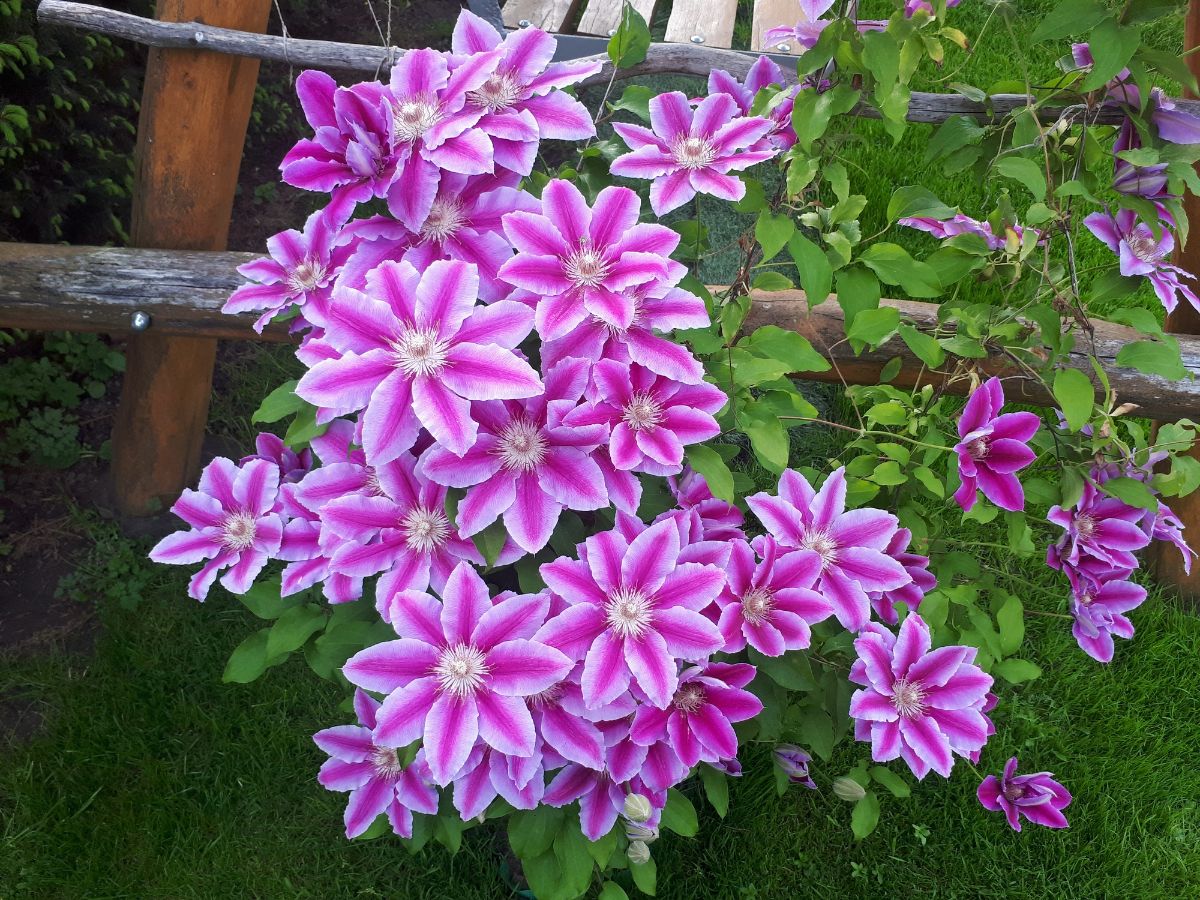
Widely known for its vibrant purple blooms, the clematis is a gorgeous climbing houseplant that thrives outdoors. Plant it near a fence or trellis, and watch it climb and grow new blooms throughout the summer. By its third year, the clematis should produce an abundance of vines and flowers all season long. Some species of clematis bloom through September.
- Sun needs: Keep this stunning plant in full sun, although certain species prefer partial shade. Read the label carefully to determine which type you have, and plant it accordingly.
- Water: Clematis prefer a moist environment, so make sure you water your plant regularly. Add some mulch around the base of your clematis to help retain moisture in the soil.
- Why this plant is a good fit: Not all clematis plants bloom with purple flowers. Some grow beautiful blooms of light pink or white, making them a colorful addition to your garden.
13. Chinese Money Plant (Pilea peperomioides)
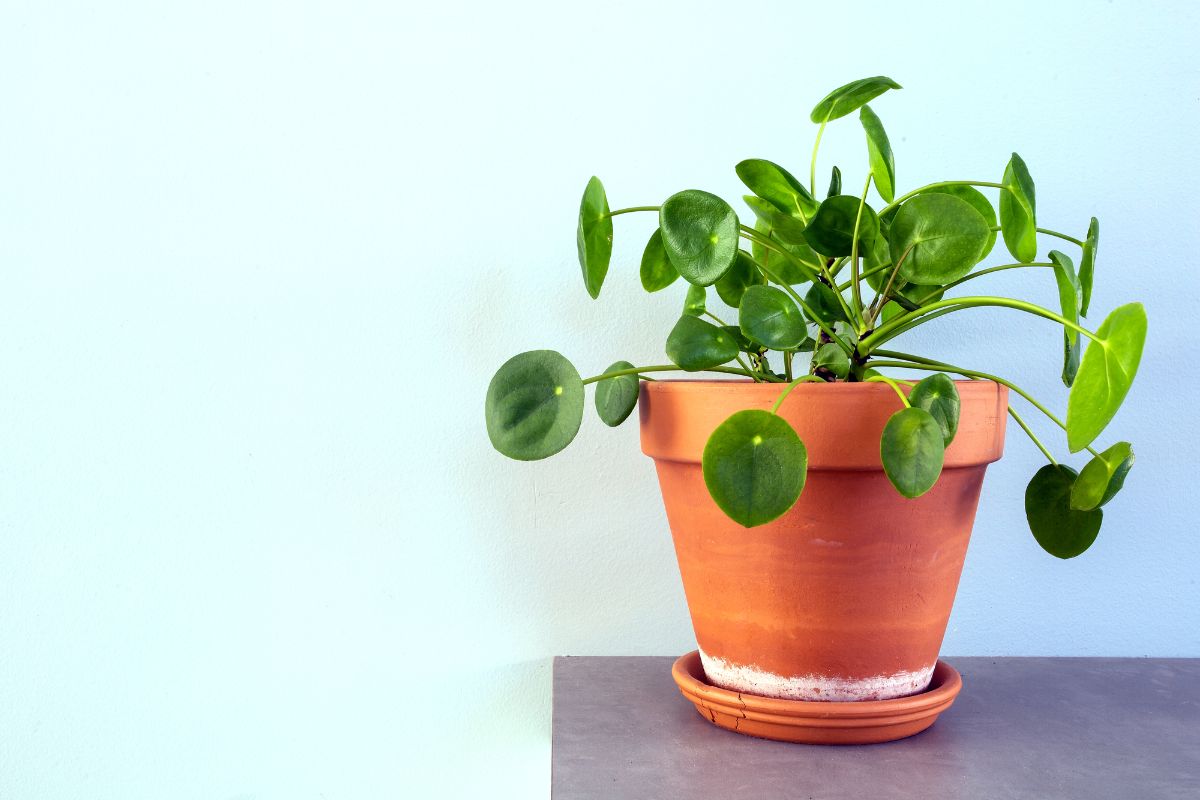
The Chinese money plant – often called the pancake plant, is well-known for its round, charming, pancake-like leaves. When staked or placed near a trellis for support, this unique dark-green houseplant will climb upward like a vine. Its thin, round leaves make it a fun accent plant for any part of the home.
- Sun needs: The pilea likes to be in bright, indirect light. If it is placed in direct sun, it could burn the leaves. Rotate the plant a few times a week to keep it upright, since it likes to grow toward the sun.
- Water: It’s time to water your Chinese money plant when approximately 75% of the top of the soil is dry. Add enough water until it flows through the drainage holes in your pot, then discard any water left in the saucer.
- Why this plant is a good fit: This climbing houseplant is a fast grower, easy to care for, and adds a fun, unique piece of greenery to a home or office space.
14. String of Hearts (Ceropegia woodii)

The string of hearts is a vining succulent with variegated, heart-shaped leaves featuring beautiful silver markings with cream, pink, and green. This unique succulent also has vibrant purple stems that get to a length of between three and nine feet long. Hang it in a basket and enjoy its cascading vines that come down like a beautiful waterfall.
- Sun needs: Keep the string of hearts in a sunny area that doesn’t get too much direct light. If the plant is in direct sun, it may cause the leaves to dry out or stunt its growth. You can take it outside for three to four hours every day to give it some indirect sunlight and afternoon shade.
- Water: Soak the plant in the spring and summer when the top two to three inches of soil are completely dry. The string of hearts goes dormant in the winter, so you should only water it once every few weeks during this time of year.
- Why this plant is a good fit: The long, purple vines and colorful leaves make this trailing, climbing houseplant a gorgeous addition to an indoor garden, sunroom, or office area.
15. Monstera (Monstera adansonii)
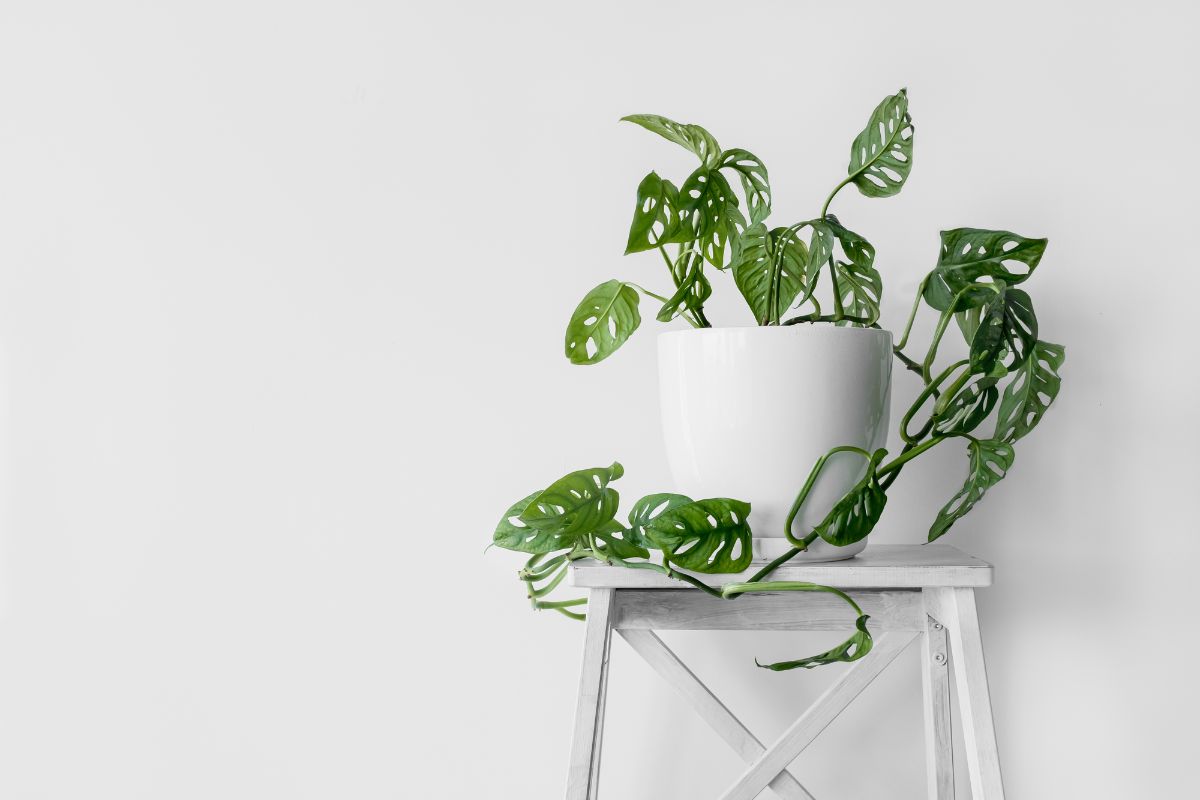
The monstera has easily become one of the most popular climbing houseplants as of late. This tropical plant is native to Central America. Holes that naturally form in the leaves have given it the nickname “the Swiss cheese plant.” The gorgeous, dark green leaves lend a tropical vibe to your home and will transform your space into a lush, island-like oasis.
- Sun needs: The monstera does best in bright to medium indirect light, although it may acclimate to handle more frequent direct light if it’s introduced to it slowly.
- Water: Water your monstera with room-temperature water every one to two weeks, allowing the soil to dry out in-between waterings.
- Why this plant is a good fit: This gorgeous tropical plant grows upward and creates a luscious element for a home or office.
Sources:
 pyomn
pyomn



